Transport in Portugal is well-developed and diversified. Portugal has a 68,732 km (42,708 mi) network of roads, of which almost 3,000 km (1,864 mi) are part of a 44 motorways system. Brisa is the largest highway management concessionaire. With 89,015 km2, Continental Portugal has 4 international airports located near Lisbon, Porto, Faro and Beja. The national railway system service is provided by Comboios de Portugal. The major seaports are located in Leixões, Aveiro, Figueira da Foz, Lisbon, Setúbal, Sines and Faro.
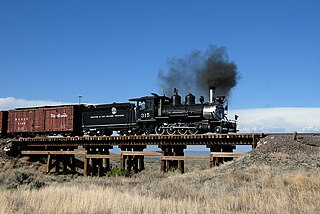
Conservation and restoration of rail vehicles aims to preserve historic rail vehicles.

A tram-train is a type of light rail vehicle that meets the standards of a light rail system, but which also meets national mainline standards permitting operation alongside mainline trains. This allows services that can utilise both existing urban light rail systems and mainline railway networks & stations. It combines the urban accessibility of a tram or light rail with a mainline train's greater speed in the suburbs.

The Porto Metro, part of the public transport system of Porto, Portugal, is a light rail network that runs underground in central Porto and above ground into the city's suburbs. Metro do Porto S.A. was founded in 1993, and the first line of the system opened in 2002.

The Santa Justa Lift, also called Carmo Lift, is an elevator, or lift, in the civil parish of Santa Justa, in the historic center of Lisbon, Portugal. Situated at the end of Rua de Santa Justa, it connects the lower streets of the Baixa with the higher Largo do Carmo.

CP — Comboios de Portugal, EPE is a state-owned company which operates passenger trains in Portugal. Before June 2009, CP stood for Caminhos de Ferro Portugueses although the company has been using its current designation as a brand name since 2004.

Europe has an extensive number of tramway networks. Some of these networks have been upgraded to light rail standards, called Stadtbahn in Germany, premetros in Belgium, sneltram in the Netherlands, elétrico in Portugal and fast trams in some other countries.
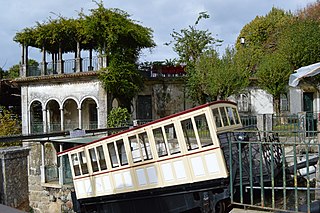
The Bom Jesus do Monte Funicular, is a Portuguese funicular transport in civil parish of Nogueiró e Tenões, in the municipality of Braga, in the district of the same name. Operated by the Irmandade de Bom Jesus do Monte the funicular connects the upper-town of Braga with the Shrine on which it gets its name, over a distance that parallels the Escadaria de Bom Jesus to the highest point at the statue of Saint Longinus.

In February 2009, the government of Portugal announced plans to build a high-speed rail line from Lisbon to Madrid; this plan was cancelled in March 2012 amidst a bailout programme of financial assistance to the Portuguese Republic. The project was valued at €7.8 billion and the government had claimed it would create 100,000 jobs. The line would link to Spain's Southwest Corridor.
The CP Urban Services network is the commuter train network of Metropolitan Lisbon and Metropolitan Porto, Portugal. It is a Comboios de Portugal company. It connects the city centers with the suburbs.

The Santa Teresa Tram, or Tramway, is a historic tram line in Rio de Janeiro, Brazil. It connects the city centre with the primarily residential, inner-city neighbourhood of Santa Teresa, in the hills immediately southwest of downtown. It is mainly maintained as a tourist attraction and is nowadays considered a heritage tramway system, having been designated a national historic monument in 1985. The line has a very unusual gauge: 1,100 mm. The main line is 6.0 kilometres long.

The Dresden tramway network is a network of tramways forming the backbone of the public transport system in Dresden, a city in the federal state of Saxony, Germany. Opened in 1872, it has been operated since 1993 by Dresdner Verkehrsbetriebe (DVB), and is integrated in the Verkehrsverbund Oberelbe (VVO).

The tram system of Porto in Portugal is operated by the Sociedade de Transportes Colectivos do Porto (STCP) and currently has three regular tram routes with 30-minute headways. All are heritage tram routes, as they use vintage tramcars exclusively, and should not be confused with the modern Porto Metro light rail system.
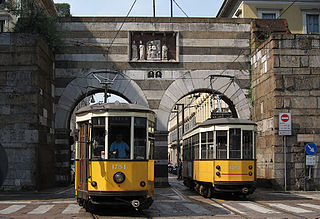
The Milan tramway network is part of the public transport network of Milan, Italy, operated by Azienda Trasporti Milanesi (ATM).

The Lisbon tramway network is a system of trams that serve Lisbon, capital city of Portugal. In operation since 1873, it presently comprises six lines. The system has a length of 31 km, and 63 trams in operation. The depot is located in Santo Amaro, in Alcântara.

Portugal formerly had several hundred kilometres of narrow-gauge railways, but by 2010 only two lines were still in operation – the Vouga line and the Metro de Mirandela. The lines were operated by Comboios de Portugal and maintained by REFER.
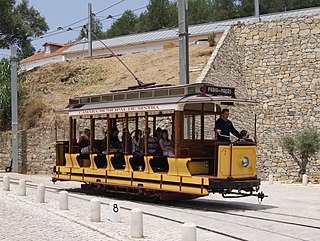
The Sintra tramway is a seasonal narrow gauge tourist tram line in Portugal. It links the town of Sintra with Praia das Maçãs, passing through Colares and close to the Praia Grande (Sintra). It has a length of some 11.5 kilometres (7.1 mi).
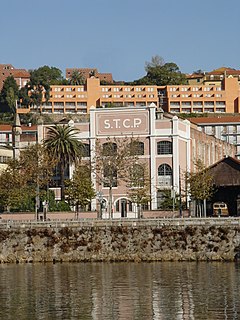
The Porto Tram Museum(Museu do Carro Eléctrico) is a museum operated by the Sociedade de Transportes Colectivos do Porto. It was inaugurated in 1992 and is installed in a former thermoelectric power station next to the River Douro in Massarelos, Porto, Portugal. It exhibits material related to the history of trams in Porto. The collection contains 16 electric cars, 5 trailers, and two maintenance vehicles as well as the former equipment of the power plant, which provided electricity for the tram lines.




















